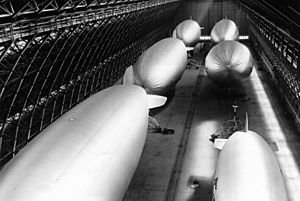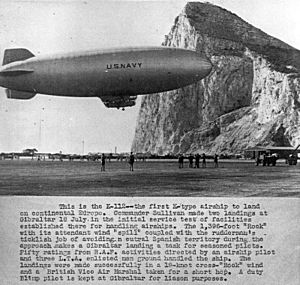US Navy airships during World War II facts for kids
The United States Navy had a big idea during World War II: use special airships, called blimps, to protect the American coast. They wanted to build many new bases for these blimps. These bases would have huge hangars, which are like giant garages for airships. They would also have places to store helium (the gas that makes blimps float) and homes for the sailors who worked with the blimps.
In 1941, the US government approved a plan to build eight of these new bases. This would allow the Navy to have 48 airships ready for action. Some of these new hangars were built at places like Lakehurst and Moffett Field, where there were already some airship facilities.
Contents
Blimps Join the War Effort
When Japan attacked Pearl Harbor on December 7, 1941, the United States joined World War II. At that time, the US Navy had 10 blimps. These included:
- K-class blimps: Four blimps (K-2, K-3, K-4, K-5) designed for patrolling.
- TC-class blimps: Two older blimps (TC-13, TC-14) that the Navy got from the US Army.
- L-class blimps: Three smaller blimps (L-1, L-2, L-3) used for training.
- G-class blimp: One blimp built in 1936, also for training.
These blimps were quickly put to work. Their main job was to find and stop enemy submarines. These submarines were sinking American ships close to the coast. On January 2, 1942, the Navy created a special group called ZP-12 at Lakehurst. This group used the four K-class blimps. A month later, another group, ZP-32, was formed in Sunnyvale, California at Naval Air Station Moffett Field. This group used the TC and L-class blimps. Moffett Field also became a training center for blimp crews.
The Navy remembered how useful airships were in World War I for fighting submarines. So, they quickly asked for many new, modern blimps. To house these new blimps, the Navy built 17 large wooden hangars. These hangars were over 1,000 feet long!
Building More Blimps
Most of the Navy's blimps were built by the Goodyear factory in Akron, Ohio. Some were also put together at Moffett Field in California.
From 1942 to 1945, the US Navy built 154 new airships. Most of these were K-class blimps, which were very good at patrolling. Some of Goodyear's blimps that were used for civilian purposes were also given to the Navy. These blimps helped with patrols even before they were officially part of the Navy.
Blimp Crews and Training
The number of people working with blimps grew a lot during the war. From 1942 to 1944, the number of military personnel increased from 430 to 12,400. About 1,400 pilots and 3,000 support crew members were trained to work with these airships.
Blimp Squadrons and Their Missions
The Navy organized its blimps into different groups called "Fleet Airship Wings." Each wing covered a specific area.
Blimps on the East Coast
The main base for Fleet Airship Wing One was at Naval Air Station Lakehurst, New Jersey. This wing had several squadrons, including ZP-12, ZP-15, ZP-14, and ZP-11. They also used smaller fields in places like Maine and Nova Scotia.
Blimps Go Overseas
In 1944, the Navy sent a whole squadron of eight K-class blimps from North Carolina to Naval Air Station Port Lyautey in French Morocco. Their important job was to find and destroy German U-boats (submarines) near the Strait of Gibraltar. This area was important because it was a narrow passage for ships.
These blimps used a special tool called magnetic anomaly detection (MAD). MAD could find submarines by sensing changes in the Earth's magnetic field. This worked best when flying low. Airplanes like the Consolidated PBY Catalina also searched for submarines, but flying low at night was dangerous for them. Blimps were perfect for this job because they could fly slowly and steadily at low altitudes, especially at night. This created a continuous "barrier" to stop U-boats.
The first two blimps, K-123 and K-130, made history on June 1, 1944. They flew all the way across the Atlantic Ocean, becoming the first nonrigid airships to do so!
By 1945, the blimps of the ZP-14 unit had completely blocked the Strait of Gibraltar for enemy submarines. Blimps from the ZP-12 unit even helped sink the last German U-boat, U-881, before Germany surrendered. The blimps of ZP-14 also helped find naval mines and escorted important convoys, including the one carrying President Franklin D. Roosevelt to a big meeting in 1945.
Blimps in the Caribbean and Gulf of Mexico
Fleet Airship Wing Two was based at Naval Air Station Richmond, Florida. This wing protected the Caribbean Sea and the Gulf of Mexico. Its squadrons included ZP-21, ZP-22, and ZP-23. They also had auxiliary fields in places like Key West and Brownsville, Texas. They patrolled areas around Cuba and Jamaica.
Blimps on the West Coast

Fleet Airship Wing Three was based at Naval Air Station Moffett Field in California. This wing was in charge of protecting the west coast of the United States. Its squadrons were ZP-32, ZP-31, and ZP-33. They used many smaller fields along the coast in California, Oregon, and Washington.
In January 1942, the ZP-32 squadron was formed at Moffett Field. They soon received two TC-class blimps (TC-13 and TC-14). These blimps had been stored at Lakehurst and were shipped by train to Moffett Field.
Blimps in South America
Fleet Airship Wing Four had squadrons, ZP-41 and ZP-42, based in Brazil. They used auxiliary fields in various locations along the Brazilian coast.
Blimps in the Southern Caribbean
Fleet Airship Wing Five had its squadron, ZP-51, based in Trinidad. They also used auxiliary fields in Guyana and Suriname.
How Blimps Helped Win the War
From January 2, 1942, until the end of the war, blimps in the Atlantic Ocean flew over 378,000 hours on more than 37,000 flights.
During the war, many ships without blimp escorts were sunk by enemy submarines near the US coast. However, out of about 89,000 ships that were protected by blimp convoys, only one was sunk by the enemy! This shows how effective blimps were.
Blimps would attack submarines with depth charges, which are bombs dropped into the water. They were very good at forcing submarines to dive underwater. Once a submarine was underwater, it was slower and couldn't travel as far, making it harder for them to attack convoys. Blimps didn't always sink submarines on their own, but they were excellent at keeping them away from valuable ships.
Only one blimp, a K-class airship called K-74, was destroyed by a U-boat. This happened on July 18, 1943, off the coast of Florida. K-74 found a German submarine using its radar. The blimp tried to attack, but the U-boat fired first. K-74 was badly damaged and landed in the water. The crew was rescued, but sadly, one crewman, Isadore Stessel, died from a shark attack. The U-boat, U-134, was slightly damaged and was later sunk by other aircraft and a British ship.


